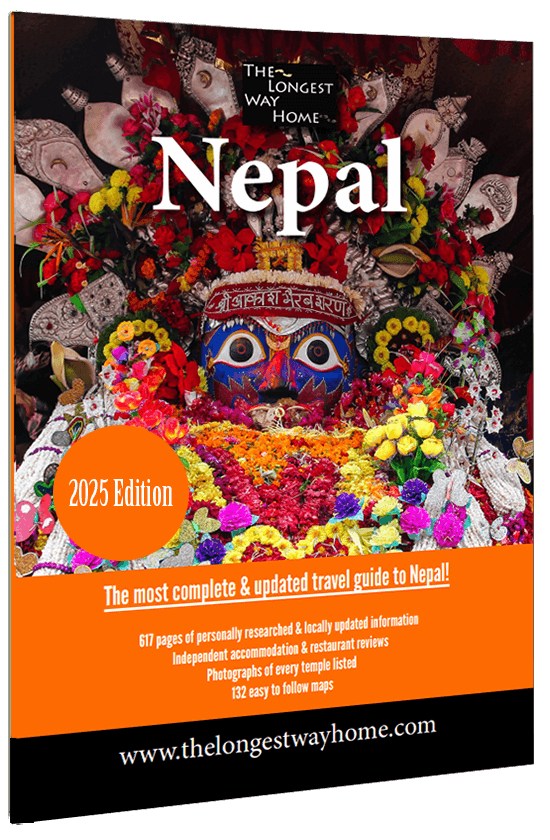The Guru Lhakhang Monastery
Located directly opposite the steps of the famous Boudhanath stupa is Guru Lhakhang Monastery, also known as Tamang Gompa. It's likely one of the most visited monasteries in the area due to its prime location and stunning views of the stupa.

The Ajima Hariti shrine outside the Boudha stupa is a convenient spot from which to view the Guru Lhakhang Monastery (Tamang Gompa).
There are three main areas within the monastery, all of which are worth visiting, even if you are not particularly interested in Buddhism or monasteries.
Did you know?
There's a large prayer wheel to the left of the main entrance to Tamang Monastery, which you can spin (rotate clockwise around it).
A Gompa is the Tibetan term for a monastery.
About the Guru Lhakhang Monastery
The Guru Lhakhang Monastery is named after Guru Rinpoche (Padmasambhava), an 8th-century Buddhist master from the Indian subcontinent, who played a significant role in establishing Buddhism in Tibet.
The monastery is commonly referred to as Tamang Gompa because of the many ethnic Tamang who reside and practice Buddhism there.
About the Tamang
The Tamang are indigenous people found in the mountainous regions of Nepal. Their genetic heritage is primarily Tibetan, but it traces back to Mongolia.

In Nepal, the Tamang constitute approximately 7% of the population. Due to their cultural practices, the Tamang are not permitted to marry outside their own ethnic group, which has resulted in certain genetic issues within clans.
Although the Tamang's origins can be traced back to Mongolia, it's crucial to note that the group was present in Nepal before the formation of the state.
The Tamang follow the Tibetan school of Vajrayana or Tantric Buddhism. In this tradition, it is common for the children of Lamas to marry other Lamas' children.
Within Tamang society, death rituals hold the highest regard. Many murals within the Tamang monastery depict death or the wheel of life.
Ground Floor of the Monastery
Before entering the main monastery, take a moment to observe the area to your left. There, you'll find a square-shaped enclosure housing a massive prayer wheel that extends from floor to ceiling. It is fully functional and features the Omadi Padme Hum mantra engraved on it. Shoes are allowed in the main stairwell, but needf to be removed when entering any prayer areas.

Remove your shoes and proceed straight into the main prayer hallway. Since the Tamang monastery is active, there will likely be monks engaged in prayer. Alternatively, if you see several rows of monks facing each other, they may be participating in a ceremonial ritual.
If you encounter a ritual, avoid walking directly down the main prayer hallway. Instead, navigate to the left and around the large red pillars.
Photography is permitted, but please refrain from using flash or taking pictures of monks without obtaining permission first.
Around the inner wall, you'll find a variety of Buddhist statues and murals, leading to the central area where a large statue of Buddha stands. Feel free to circle around if there are no services in progress. Once you're done, exit the hallway and ascend the stairs.
Second Floor of the Monastery
As you climb the stairs to the upper floor, you'll be captivated by the elaborate murals adorning the walls, heavily influenced by Tibetan symbolism.

The wheel of life and the murals on both the first and second floor landings are particularly notable.
Upon reaching the main floor, you'll find an entrance to a smaller area with five guardian lion statues above the intricately painted door embedded in the massive mural-covered wall.
Inside, you'll discover a small glass-encased statue of Buddha, and the atmosphere will be quieter and slightly dimmer than below. There will likely be a stronger scent of incense in this room, and fewer visitors. While entry is permitted, please remember to remove your shoes.
From the main doorway in the balcony area, you'll enjoy a magnificent view of the stupa. Resist the temptation to overdo it with photography and head to the roof for the best perspective.
Rooftop of the Monastery
The rooftop of Tamang Monasteries is often considered its most impressive feature for many visitors. After exiting the staircase, you'll find a small roofed area straight ahead, housing another statue of Buddha.

Looking forward from the Gompa, you'll be greeted by one of the finest views of the stupa in the vicinity. By day, you'll also have a panoramic view of the Ajima Hariti Shrine and the entire stupa area.
At night, the area becomes particularly serene when the stupa is illuminated with floodlights and colored lights.
Returning your gaze, you'll spot a small hut to the left. This is where visitors can purchase butter lamps for about 5 rupees to light and offer prayers.
Entrance fee for Guru Lhakhang Monastery
There is no fee to enter the monastery. There are a few low key donation boxes dotted around each floor.
Explore Nepal with My Guidebooks
Enjoyed this page? You're going to love my guidebooks! Dive into hands-on, comprehensive guidance that outshines the rest. My books bring you closer to Nepal through meticulously researched information, vibrant photographs, and travel-tested walking tours that ensure you experience all the attractions with unparalleled precision.
Choose your adventure in either print or digital format - the ultimate companion for your Nepalese journey.
Was this page helpful to you? If so please tell others!



